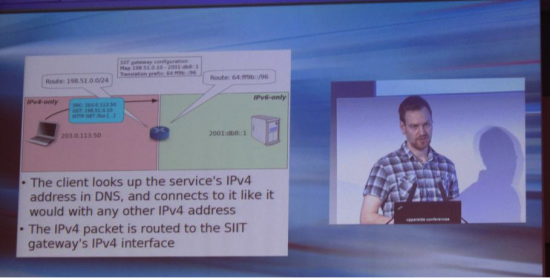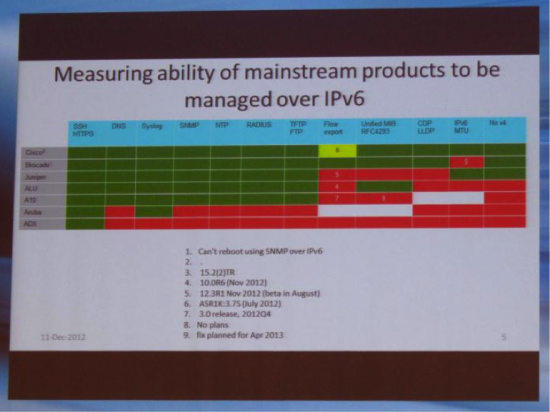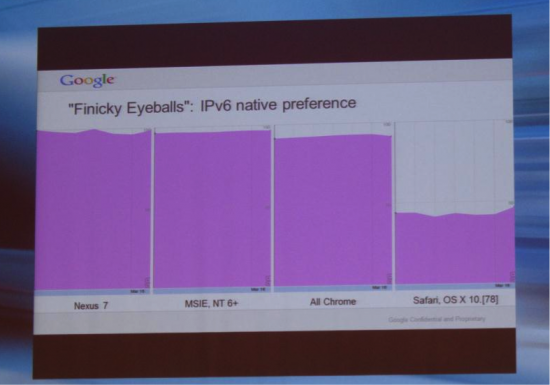
By Steve Simlo, IPv6 Product Manager, Cisco Network Operating Systems Technology Group
The World IPv6 MPLS / Ethernet / SDN World Congress events wrapped up recently with over 500 industry specialists in attendance, including myself. For 3 days the buzz was on how IPv6 has advanced since last year’s World IPv6 Launch to become reality.
Day One focused on Mobile, Day Two on Bring Your Own Device (BYOD), Home networking and emerging Cloud and Core applications of IPv6 and Day Three looked at Security and Measurements.
Here is my personal summary of a few of the items that I found most compelling:
1. Mobile IPv6 based deployments are happening now. Providers such as Verizon and T-Mobile are offering real services over LTE. In addition we are seeing some emerging niche services such as the “Advanced Emergency Response Service” in Slovenia being deployed to leverage some of the emerging advanced capabilities of IPv6 in terms of QoS, policing, marking and advanced unicast and multicast routing.
2. IPv6 is becoming the basis for emerging services in the wireline space. Particularly interesting in this regard was the TeraStream architecture deployed by Deutsche Telekom which carries IPv4 over an IPv6 only core as a service. Ian Farrer of DT explained how they are using space within the IPv6 address header to insert service semantics for the purpose of traffic differentiation

3. IPv6 Core Transport will benefit from a very innovative announcement made by Cisco called Segment Routing. Clarence Filsfils explained how SR places “the state in the packet” (and not in the network) to allow services such as Traffic Engineering, Fast re-route and other (typically MPLS dependent) services to be delivered without incurring the overhead of needing an MPLS core. The technology has been submitted to the IETF as an Internet Draft and is entirely backwards compatible with existing deployments with a data plane that can use MPLS or IPv6 and a control plane that leverages ISIS or OSPF.
4. IPv6 is also becoming highly relevant to Data Centre architectures. Tore Anderson of REDPILL-LINPRO presented the case for an IPv6 only Data Centre Architecture and explained how stateless NAT could be used to map the entire IPv4 Internet into a /96 of the IPv6 space and remove the need to manage 2 separate stacks within the Data Centre Environment.

5. Transitioning to a world where IPv4 becomes a service carried by an IPv6 transport is becoming increasingly important and in this respect stateless technologies such as Mapping of Address and Protocol (MAP) offer huge promise to help scale future transitions.
Many interesting statistics on IPv6 deployment were highlighted, including sites such as Cisco 6Labs or http://6lab.cisco.com/stats/.
One area of good news for Cisco was shared by Ron Broersma of Defense Research and Engineering Network, which compared different vendors in terms of their ability to manage their platforms natively over IPv6 based on support for mainstream transports such as DNS, SSH, FTP, and TFTP. It’s hard to see from the photograph but we had no “reds” and only one yellow – the best of any networking vendor.

Not everything was good news. During the panel discussion on “measuring IPv6” it was highlighted that the way different operating systems and browsers are interpreting and employing the “Happy Eyeballs” RFC was leading to some wide variations in the experiences of users on Dual Stack Networks depending on their OS / browser combination. Particularly problematic was the Mac / Safari / OSX platform in this regard.

In spite of these minor issue the future for IPv6 does look very positive. Real services are emerging and deployments are happening. Traffic growth is on an exponential trajectory!

I wish I was there. This has renewed my interest in the potential of IPv6. I love the exponential nature of the Network. That is why I am in this field.
I do have a few questions for those developing IPv6. Has anyone considered how nanotechnology will impact IPv6? Ray Kurzweil, Michio Kaku and others have described a day in the future where we can choose to have neural implants attached to each neuron and sensors throughout the body to improve health and function. Given roughly 100 billion neurons alone, will we really have enough addresses? Or will a new communications platform be created for these breakthrough technologies? And, don’t forget the billions, if not trillions of sensors that will be deployed almost everywhere in the world.
IPv8 anyone? Just a thought…
There are many methods to probably solve this. Will every neuron need to be uniquely addressed? Or will this be done at the person level? In any case, I hope I live to see the day when this problem is solved! Thanks for reading!
Thanks Steve and Stephen. I hope I live that long too. Twenty to thirty years of exponential technological advancements are hard to wrap your head around. I expect we will see things we cannot even imagine yet.
Thanks for your comments Matthew